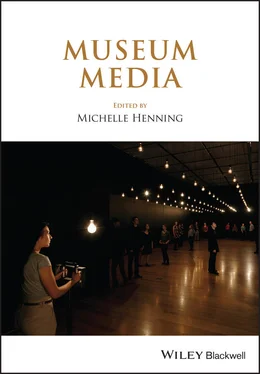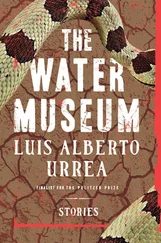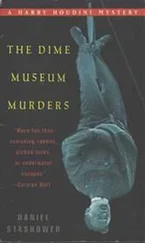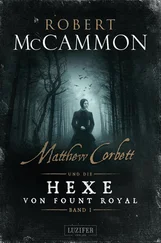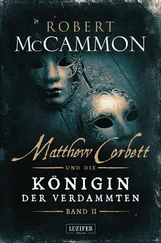Museum Media
Здесь есть возможность читать онлайн «Museum Media» — ознакомительный отрывок электронной книги совершенно бесплатно, а после прочтения отрывка купить полную версию. В некоторых случаях можно слушать аудио, скачать через торрент в формате fb2 и присутствует краткое содержание. Жанр: unrecognised, на английском языке. Описание произведения, (предисловие) а так же отзывы посетителей доступны на портале библиотеки ЛибКат.
- Название:Museum Media
- Автор:
- Жанр:
- Год:неизвестен
- ISBN:нет данных
- Рейтинг книги:4 / 5. Голосов: 1
-
Избранное:Добавить в избранное
- Отзывы:
-
Ваша оценка:
- 80
- 1
- 2
- 3
- 4
- 5
Museum Media: краткое содержание, описание и аннотация
Предлагаем к чтению аннотацию, описание, краткое содержание или предисловие (зависит от того, что написал сам автор книги «Museum Media»). Если вы не нашли необходимую информацию о книге — напишите в комментариях, мы постараемся отыскать её.
Museum Media — читать онлайн ознакомительный отрывок
Ниже представлен текст книги, разбитый по страницам. Система сохранения места последней прочитанной страницы, позволяет с удобством читать онлайн бесплатно книгу «Museum Media», без необходимости каждый раз заново искать на чём Вы остановились. Поставьте закладку, и сможете в любой момент перейти на страницу, на которой закончили чтение.
Интервал:
Закладка:
While Gaskell is interested in the treatment by museums of sacred or numinous objects, Candlin is interested in the ways in which small, informal museums avoid the sense of deadened or impotent objects by not separating objects from the originating community, by being situated in an environment “broadly consonant with its interests” and by mediating its objects in such a way that they seem more immediate and “alive” ( Chapter 13). The notion of liveness as something that is produced through display practices also resonates in anthropologist Petra Tjitske Kalshoven’s chapter. She writes about living history and re-enactment practices that animate museum objects, bringing them to life through replication and performance in ways that “both defy and celebrate the sanctity of the museum space” ( Chapter 24). She sees this in terms of play, which, following Johan Huizinga’s famous study Homo Ludens ([1950] 1967), she describes in terms of the construction of temporary “worlds apart.” In Kalshoven’s account, museum objects are given back their usefulness, but as replicas, miniatures, and in the context of the intense experience of historical re-enactment. For her, the liveliness of objects comes in their integration into play, or via the careful staging of objects in exhibition giving them the opportunity to “perform.”
Fiona Candlin’s account gives the sense that it can be a certain carelessness of staging that enlivens objects, producing a powerful sense of the “having been there” of past occupants, through used objects that metonymically suggest their presence: shoes “molded to the shape” of the owner’s feet, “half-used” soap, doors “stained with the grease of repeated touch” ( Chapter 13). A more chaotic, unregulated appearance might actually add to a sense of unmediated presence. Yet legibility depends on staging: as Caroline Morris has said about Charles Darwin’s study at Down House, the visitor’s ability to read the room as narrating the presence of Darwin and his activities within the study is enhanced by the careful placing of objects: “the cluttered table and carefully positioned stool narrate the chair’s use” (Morris 2013).
Ivan Gaskell argues that museums mediate not only through exhibitions, but also in their other practices, in laboratories and storage rooms. He shows how mediation occurs through conservation practices, and through prohibitions and rules: such as those preventing the touching of objects and the application of other substances such as incense or smoke, which are part of acts of veneration. Rules against handling of collections not only prevent “ritual interactions” but sometimes “appear to protect the power privileges of museum staff rather than serve demonstrable utilitarian purposes.” Even the most practical regulations can also operate symbolically, as “a way of establishing, enforcing, or contesting power hierarchies” ( Chapter 8).
Touch prohibitions arrived both with the development of the museum as a disciplinary institution and as an imperial institution. According to Erkki Huhtamo, prohibitions on touching in art museums arrived with the nineteenth-century public museum. Visitors to early museums expected to be able to touch artworks. However, the new déclassé audiences of the public museum were not trusted to behave appropriately ( Chapter 12). Today, Huhtamo suggests, museums can no longer rely on shared ideas about acceptable behavior in a museum context, and it is increasingly difficult to enforce touch prohibitions. He attributes this to a combination of the juxtaposition of touchable and untouchable works in the same spaces, and the growing tactility of a society acculturated to touch screens and push buttons. This notion – that visitors import into the museum behaviors and ways of seeing that are associated with other media or other exhibitions contexts – has had a long circulation: for instance, Sue Perks, in her chapter later in the volume, refers to 1970s discussions in which museum professionals diagnosed a new kind of inattentiveness in visitors, attributing this to the negative influence of television ( Chapter 18).
Atmospheres of display
In many museums, intangible qualities, such as light, smell, sound, and climate, are very carefully controlled. Museums and galleries mediate objects through environmental technologies. Systems necessary for preservation purposes also affect visitor experience: displaying the watercolors of William Blake in a dimly lit room prevents them from fading, but it can also produce a sense of intimacy and add to the dreamlike, almost hallucinatory, quality of the pictures, reinforcing the narrative of Blake as a visionary. Light is a particularly powerful mediating tool because, while it renders things visible, it often passes unnoticed. Alice Barnaby’s chapter shows how light has a role in producing certain kinds of valued aesthetic experiences, by charting changes in exhibition lighting in Britain over a 100 year period, from 1750 to 1850 ( Chapter 9).
The idea of lighting as a media technology is not new. McLuhan used the example of the electric light bulb to explain the concept that “the medium is the message” in his book Understanding Media ([1964] 2001). For McLuhan the light bulb is a medium without any content, which nevertheless makes possible certain kinds of social practice and experiences. 5By contrast, Alice Barnaby sees light as having a symbolic content that is closely tied to its technical form. In 1961 the exhibition designer Herbert Bayer listed light among the “combined means of visual communication” that made exhibition design “an intensified and new language” (quoted in Staniszewski 1998, 3). In fact, Barnaby shows that this language was already being developed by means of new lighting technologies in the early nineteenth century, when light was used for “the staging of statements about wealth, power, and taste” ( Chapter 9). Cultural trends in art gallery lighting were linked to ideas about who should have access to public art collections, and what they ought to get from the experience, with different lighting styles seeming to produce “civilizing effects” associated with rationality and civic virtue or producing a sensuality and poetic quality that confirmed an aristocratic sensibility.
Barnaby’s discussion of the nuances of different approaches to lighting in this period provides a different perspective from accounts of museums as “hegemonic disciplinary structures,” instead making vivid the “multiple and seemingly contradictory agendas” which produced and popularized a wide range of different lighting practices ( Chapter 9). Nevertheless, Barnaby shares with these accounts an emphasis on the visual and visibility. Rupert Cox’s chapter challenges this emphasis, offering sound and aurality as a means to rethink social relations in art museum and gallery contexts. He suggests we think of museum space in terms of acoustics and address “listening as part of the sensorium through which museum visitors engage with artworks” ( Chapter 10). The materials used in new museum interiors are chosen with acoustics in mind: to dampen or muffle the sound of footsteps or of visitors talking, for instance. At the same time, there are various uncontrolled sounds – air conditioning and heating systems – or sounds from nearby displays. Inviting visitors to attend to such sounds means inviting them to think differently about the museum space. This attentiveness to sound is something that has been encouraged by the sound art installations and projects Cox discusses.
Cox argues that sound can be experienced by visitors as ambiguous and dispersed, bodily felt rather than cerebrally interpreted ( Chapter 10). While he discusses sound art in terms of “affective space” – with “the absence of a fixed viewing perspective,” Brigitte Biehl-Missal and Dirk vom Lehn point to how atmosphere in general is experienced bodily as “indeterminate, a spatially extended quality of feeling” ( Chapter 11). The construction of atmospheres in museums and retail environments involves architecture, lighting, color, sound, electronic media, and even the behavior and speech of staff. Biehl-Missal and vom Lehn see atmospherics as a means of ideological manipulation because it includes intangible aspects which nevertheless impact on the museum experience. Designed or manufactured atmospheres appear to bypass symbolic communication altogether, working directly on feelings – Bettina Habsburg-Lothringen refers to the discipline of constructing atmosphere as “emotional design” ( Chapter 15).
Читать дальшеИнтервал:
Закладка:
Похожие книги на «Museum Media»
Представляем Вашему вниманию похожие книги на «Museum Media» списком для выбора. Мы отобрали схожую по названию и смыслу литературу в надежде предоставить читателям больше вариантов отыскать новые, интересные, ещё непрочитанные произведения.
Обсуждение, отзывы о книге «Museum Media» и просто собственные мнения читателей. Оставьте ваши комментарии, напишите, что Вы думаете о произведении, его смысле или главных героях. Укажите что конкретно понравилось, а что нет, и почему Вы так считаете.
